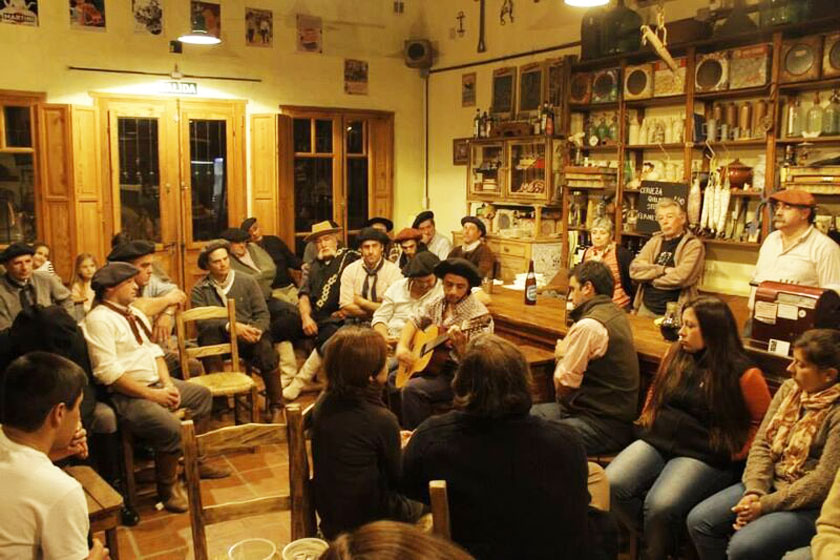For those unfamiliar with the Argentine pulpería, they can best be described as a mixture of part wild west saloon bar, part restaurant, and part deli. Historically, the country’s gauchos would stop by to catch up on news from the city, after weeks working alone in the country, herding wild cattle and horses.
Yet pulperías have never been restricted to the countryside and many could also be found in the city. To this day some of the original pulperías remain in the historic barrios (neighborhoods) of Buenos Aires. Other, newer pulperías operate in the spirit of the originals, though their appearance and locations are more modern.
The origin of the name pulpería is disputed. Some historians believe that it is derived from the Spanish words pulpo and pulpa and suggest that the owners of the original pulperías made their money selling pulpo (octopus) or pulpa (fruit purees) to colonial settlers. Others argue that the name originates from the Mexican moonshine pulque and is a reference to the strong, cheap alcohol served in pulperías at the time. If you’ve never stepped inside, come along for a trip through Argentina’s pulperias. [pagebreak]
One of the first pulperías on record in Buenos Aires was founded in 1580 by Ana Díaz. After arriving with Juan de Garay for the second foundation of the city, Díaz set up the pulpería on the outskirts of what was just a small village at the time. Little did she know that nearly 450 years later, the site she chose would be one of the busiest street corners in a city with a population of more than 10 million people. By the 1800’s there were around 500 pulperías in the province of Buenos Aires and many variations had evolved.
These days, the style of the pulpería is determined by its location and regular customers. The most basic pulperías existed simply to cater to the locals’ vices. They sold tobacco, rolling papers for cigarettes and different types of alcohol. The favored alcohol was moonshine – stronger and cheaper than anything else on offer. Customers could also buy their yerba (dried leaves), as was the preferred form of caffeine intake at the time, in the form of maté. (Yerba maté was, and continues to be, an important supplement to the gauchos’ diet.) [pagebreak]
Other larger, more elaborate pulperías were a place to socialize, often serving food. In this type of pulpería it was standard to have at least one or two guitars hanging on the wall, though they would not remain there for long, as visitors would take it in turns to play and sing popular folklore music. As the cheap alcohol flowed, singing and dancing continued late into the night.
Besides gauchos, a number of different shady characters also frequented these locations. If you needed to borrow money, your loan shark could be found in the pulpería. If you wanted to play cards or gamble the little money you had, your bookmaker could be found in the pulpería. If, like many gauchos unaccustomed to contact with other human beings, you enjoyed a good fight after your share of moonshine, your sparring partner could be found in the pulpería.
In recognition of the unsavory nature of a large portion of the clientele, pulperías contained large iron bars, spanning from the countertop to the ceiling. Behind these bars the pulpero (owner) was safe from the frequent drunken violence, though somewhat at a disadvantage when it came to trying to clear everyone out at the end of the night. [pagebreak]
These pulperias stille exist, to get a taste just leave the city and head to one of the many small towns and villages in the province of Buenos Aires. San Antonio de Areco is the unofficial ‘capital’ of pulperías, with the gaucho culture celebrated annually here on the Día de la Tradición (Tradition Day). These pulperías operate more often as delis than restaurants – selling cured meats, pickles, jams, and local artisanal beers. Sit around one of the handful of tables at night for the perfect place to enjoy locals playing the guitar and experience a traditional gaucho evening – though thankfully, without the rumbles.
Alternatively, in the city of Buenos Aires, some original pulperías can still be found though they are much less common. They continue to run in the familiar nature of their countryside counterparts, with customers and owners on first name terms. The slow, yet friendly service a haven from the chaos of one of Latin America’s largest cities. For one wishing to sample the simple, tasty, traditional Argentine cuisine (think empanadas and locro stews, washed down with a large Quilmes to share) these pulperías are a must visit.


![Making Mealtime Matter with La Familia: Easy Sofrito [Video]](https://thelatinkitchen.com/wp-content/uploads/2015/10/sofrito-shutterstock__0-500x383.jpg)
![Easy Latin Smoothies: Goji Berry Smoothie [Video]](https://thelatinkitchen.com/wp-content/uploads/2015/12/goji_berry-shutterstock_-500x383.jpg)
















![Fun and Fast Recipes: Fiesta Cabbage Salad [Video]](https://thelatinkitchen.com/wp-content/uploads/2015/11/fiesta_cabbage_slaw-shutterstock_-500x383.jpg)









